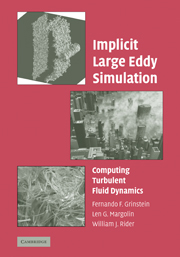Book contents
- Frontmatter
- Contents
- Preface
- List of Acronyms
- List of Contributors
- Introduction
- SECTION A MOTIVATION
- SECTION B CAPTURING PHYSICS WITH NUMERICS
- SECTION C VERIFICATION AND VALIDATION
- SECTION D FRONTIER FLOWS
- 14 Studies of Geophysics
- 15 Using PPM to Model Turbulent Stellar Convection
- 16 Complex Engineering Turbulent Flows
- 17 Large-Scale Urban Simulations
- 18 Outlook and Open Research Issues
- Index
- Plate section
15 - Using PPM to Model Turbulent Stellar Convection
from SECTION D - FRONTIER FLOWS
Published online by Cambridge University Press: 08 January 2010
- Frontmatter
- Contents
- Preface
- List of Acronyms
- List of Contributors
- Introduction
- SECTION A MOTIVATION
- SECTION B CAPTURING PHYSICS WITH NUMERICS
- SECTION C VERIFICATION AND VALIDATION
- SECTION D FRONTIER FLOWS
- 14 Studies of Geophysics
- 15 Using PPM to Model Turbulent Stellar Convection
- 16 Complex Engineering Turbulent Flows
- 17 Large-Scale Urban Simulations
- 18 Outlook and Open Research Issues
- Index
- Plate section
Summary
Introduction
In this chapter we present the rationale behind, the validation of, and the results from our numerical models of the turbulent flow of gas expected in the convection zones of various types of stars. We review both local area models of convection expected near the surface of solar types of stars and global models of the convection zones of red giant stars. We made the local area models in slab geometry on Cartesian meshes. Even though the geometry of the full convection zone of a red giant star is basically spherical, we also made these models on Cartesian meshes. We made these two sets of models by using variants of the piecewise parabolic method (PPM) described in detail in Chapter 4b and applied to ideal turbulent flow in Chapter 7. Both the use of an Euler-based code such as the PPM to do first-principle studies of turbulent convection as well as the use of Cartesian meshes to do calculations of spherical regions motivated quite a few tests. Our focus in this chapter is to describe the effectiveness and limits of using the PPM to study turbulent stellar convection in a variety of geometries in terms of surprising yet verifiable results.
Rewards and challenges
Both simple and sophisticated one-dimensional models of stars, as well as observation, indicate that there are regions inside many types of stars that are unstable to convection. These regions are called convection zones. The convection zone in the nearby starwe call “the Sun” spans roughly the outer third of its radius. The uppermost regions of the solar convection zone are seen on the surface as granulation.
Information
- Type
- Chapter
- Information
- Implicit Large Eddy SimulationComputing Turbulent Fluid Dynamics, pp. 439 - 469Publisher: Cambridge University PressPrint publication year: 2007
Accessibility standard: Unknown
Why this information is here
This section outlines the accessibility features of this content - including support for screen readers, full keyboard navigation and high-contrast display options. This may not be relevant for you.Accessibility Information
- 1
- Cited by
